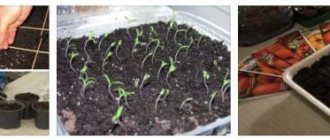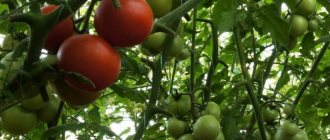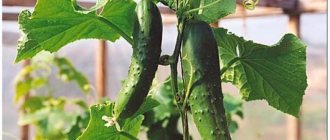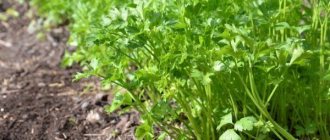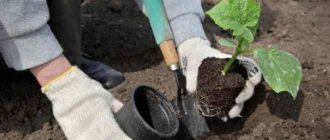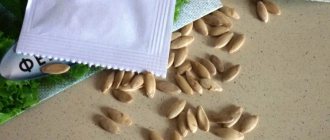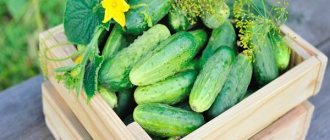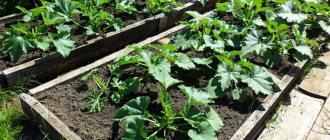How to properly grow cucumber seedlings on a window so that they do not stretch out
The seedling cultivation method has undoubted advantages:
- Extended fruiting period;
- Guaranteed harvest in cold areas;
- Receiving early products.
It should be immediately noted that the delicate cucumber tolerates transplants extremely painfully. Picking is simply contraindicated for him.
Land preparation
Lianas with edible fruits need light but moisture-absorbing soils. In addition, the soil mixture must be breathable and drained. The mineral and organic composition is added in accordance with the standard.
Some gardeners are of the opinion that if cucumber seedlings ripen quickly enough, then they do not need additional feeding before transplanting. It is quite enough if the sowing is carried out in sufficiently fertilized soil.
Summer residents who do not have sufficient experience, as well as gardeners who want to reduce preparatory work, purchase disinfected mixtures at retail outlets. Those who like to tinker with soil will enjoy preparing the necessary soil themselves.
The standard soil mixture includes 4 ingredients:
- Sand;
- Mature compost;
- Leaf soil;
- High peat.
Due to the lack of peat, they often do without it. The homemade mixture is disinfected by freezing, calcining, and steaming. After the disinfection process, nutrients are added for rapid root formation. It is also necessary to add drugs that suppress pathogenic fungi and microflora.
Add a glass of ash, 2 tablespoons of phosphorus fertilizer, 3 tablespoons of nitrophoska to a bucket of prepared soil.
Agronomists also recommend treating with biofungicides: Fitosporin, Trichodermin.
Seed preparation
In addition to the soil, seed material also needs to be prepared. Pre-sowing preparation increases the yield, makes plants more resistant to stress, and accelerates germination.
Proper storage of the material guarantees its suitability for 10 years. The highest quality seeds are 4 years old.
When collecting seeds yourself, the following points are always taken into account:
- Annual seeds do not guarantee generous harvests;
- Varietal samples repeat in terms of yield the year in which they were collected.
Packaged seeds are supplied for sale mainly processed. Your own seeds need pre-planting preparation.
- Disinfection . The seeds are kept in a manganese solution.
- Soaking . The seed bundle is placed in a humid environment until it pecks.
- Hardening . The moist bundle with seeds is kept in the refrigerator at zero temperature for two days, after which it is immediately planted.
Grains stored for more than 6 years are bubbled.
Sowing
Having carried out the preparatory work, they begin sowing. The containers are filled with soil mixture to a level of 2/3 of the height, having previously provided them with drainage. Water generously, allowing excess moisture to drain and the soil to mature.
The soil ready for planting should be crumbly, moist, but not sticky.
Place a couple of seeds in the center of each container and sprinkle with the remaining soil or sand. The powder can be easily compacted with your finger and slightly moistened.
The container with plantings is covered with film and placed in a room with a temperature of +26…+28°C.
Until the shoots appear, no watering is carried out - only light moistening and daily ventilation.
First shoots, what to do
When sprouts appear and cotyledon leaves begin to open, the temperature drops to +20...+22°C during the day, and 4-5 degrees lower at night. In accordance with the surrounding air, the soil must also be heated.
Usually, cucumber shoots do not take long to appear and appear on the 3-5th day. After mass germination, the container with seedlings is moved to the most illuminated places.
If there is a lack of light, turn on the lamps and place the containers more freely so that there is no crowding.
Seed selection and preparation
Cucumbers are biologically related to pumpkin plants. There are bush cucumbers, but climbing cucumbers, with varying lengths of vines, are more common. Another classification divides cucumbers into salad and pickling ones. There are also varieties for universal use. According to the timing of ripening, cucumbers are divided into early ripening, mid-early and mid-ripening.
There are also insect-pollinated cucumbers and parthenocarpic (self-pollinating) cucumbers. Some varieties are intended for growing in greenhouses, others in open ground (but many grow in both). Therefore, the choice depends on the preferences of the gardener and the available growing conditions.
The number of varieties and hybrids of cucumbers in stores now amounts to hundreds, however, apparently, we should not forget the old, time-tested domestic varieties. Fortunately, you don’t need to buy cucumber seeds every year, since they remain viable for a very long time. Fresh seeds are even worse than those that have lain for two or three years: they have a larger proportion of male flowers.
There are gardeners who strive to purchase the latest hybrids every spring, and there are those who plant their own varieties from year to year and take seeds from them. The situation is ambiguous: of course, there is more trust in oneself, but serious companies are now selling very good hybrids. True, there is no point in collecting seeds from them: it is unknown what will grow from it.
Most hybrid seeds are sold ready for sowing, but you need to do a little work with your own first.
It is not necessary to complete all the existing preparation steps, but experienced gardeners choose the most necessary ones, in their opinion, from the following list.
- Calibration
The cucumber seeds are quite large, and the puniest ones can be easily separated by hand. It is safer to dip the seeds in a solution of table salt (a dessert spoon in a glass of water) and shake. After a few minutes, the weak ones will float up; it is better not to sow them. - Warming up.
Before sowing, fresh seeds are kept near a heating radiator for a couple of days; this increases the proportion of female flowers. Disinfection. For seeds prepared for sale, this operation is optional. Your seeds should be treated for 15–20 minutes with a strong solution of potassium permanganate, then rinsed well with clean water. - Soaking in growth stimulants.
Some hobbyists use this technique to increase the vitality of future plants. The most harmless thing is aloe juice, diluted 5 times with water, from store-bought preparations - Zircon or Epin. - Soaking in water.
Many gardeners try to soak even purchased seeds before sowing, at least until they swell. To do this, they are kept for about 24 hours in water at room temperature or a little warmer, then dried a little so that the seeds are easily sown. This procedure can speed up the emergence of seedlings by no more than a day, so there is not much point in it. - Hardening.
To plant in a greenhouse, you do not need to harden the seeds, but for unprotected soil this operation is useful. Hardening of cucumber seeds is carried out by sending the soaked seeds in a wet cloth to the refrigerator for a day. - Germination.
Seeds are most often germinated in wet sawdust. It makes sense to do this before the primary root appears - no more than a centimeter long, otherwise it will be difficult to sow them. True, some amateurs germinate seeds directly in a rag until the cotyledon leaves appear, but planting such seeds in a garden bed will be very difficult. For seedlings, at home, in comfort, you can. But the meaning is lost: you can simply sow the seeds in pots early.
Is it possible not to do anything from the list above? Certainly. The author of these lines always sows cucumbers with dry seeds, straight from the bag. And they sprout beautifully, only a little later. Although, of course, if you have time, you can do whatever your heart desires.
Features of growing seedlings for a greenhouse
As an alternative, cucumber seedlings are grown not only in soil, but also without it at all, in eggshells, in peat glasses and in several other ways.
Without land
Landless farming is becoming increasingly popular. And there is less hassle, and cleaner window sills. As for the space occupied, space is saved at least 2 times.
However, the main advantage of the landless option is complete protection against blackleg. The grown seedlings planted in the beds are no longer afraid of this disease.
To organize planting, you will need isolon or polyethylene, toilet paper. Paper is laid out in several layers on a strip base and moistened with settled water with Epin. Cucumber seeds are placed on it. They are also covered with paper, moistened and rolled like a snail.
The rolled-up cigarette is placed in a container into which a little water is poured to maintain the required humidity. The structure is covered with a bag for a greenhouse effect. After the sprouts appear, the snails are transferred to warm, illuminated places.
Growing cucumbers without soil - a super way: video
In peat pots
The cups are filled with soil mixture, and 2 grains are laid out. Store-bought ready-made seeds are placed flat, crushed with sand or soil, lightly tamped, and watered.
The germinated material is placed carefully so as not to damage the emerging roots.
The peat pots are covered and left for the seeds to germinate.
In a shell
An interesting option for growing seedlings is in shells. They begin to be collected in advance; in addition, you will need containers in which the containers will then be installed. An egg tray and various boxes will do.
A hole is punched in each shell with an awl to remove excess liquid. The shells themselves are washed and boiled for disinfection, and filled with soil. A separate container is determined for each seed. For convenience, you can mark the variety and date on the shell. After sowing, the shells are covered with film and set aside until germination.
The plantings are ventilated daily and moistened if necessary. At the time of planting, the shells are compressed until they crack and placed in the holes along with the plant. The lime present in the shell is a good fertilizer.
Planting cucumber seedlings “in a diaper” - video
Selection and preparation of soil and planting site
In different climatic conditions, the arrangement of beds for cucumbers is somewhat different. And if in the southern regions plantings are usually carried out on a flat surface, then in the middle zone more or less high ridges are equipped. To create a better air-thermal regime on heavy soils, the ridges are built higher; on light, warm soils they are made low. On slopes, ridges are made across the slope, on a flat surface - taking into account the best solar heating - from east to west.
In areas with high groundwater levels and heavy cold soils, it is widely practiced to sow cucumbers in separate raised earthen holes located at a distance of up to a meter from one another. In dacha practice, it is not uncommon to grow cucumbers on wall beds with or without film cover. To do this, use the southern walls of buildings or blind fences. If this is not possible, cucumbers are grown on trellises protected on the leeward side by a shield made of boards or film.
The fence is an excellent natural support for cucumbers, at the same time protecting them from the winds
In addition to being thermophilic, cucumbers require higher doses of fertilizers, especially organic ones, compared to many crops. Without a good supply of nutrients to the beds, harvests are delayed and small. Even fresh manure is good for cucumbers, especially if you apply it for autumn digging. But it is better, of course, that the manure is at least half-rotted; cucumbers can use such fertilizer at first. Peat-compost mixtures are also suitable, but mineral fertilizers are still added to any organic matter - 100 g/m2 of nitrophoska or at least a half-liter jar of wood ash.
Cucumbers do well in high, warm beds. To arrange them, at the end of last summer, a hole up to 30 cm deep was dug according to the size of the future bed. Various waste was dumped into it: plant tops, small branches, fallen leaves, household garbage, various cleaning products. All this is periodically watered with infusion of mullein or chicken droppings, sprinkled with earth or peat. In the fall, add good soil and form a ridge, limiting it along the sides with boards or slate.
In the spring, the bed is sprinkled with ash, loosened, watered with warm water and covered with film until sowing the cucumbers. In the northern part of our country, the film is not removed at all, but holes are made in it, where seeds are sown or cucumber seedlings are planted.
Seedling care
To grow healthy seedlings, 3 conditions must be met: watering, temperature and lighting.
5 days after the first sprouts appear, watering the seedlings begins. This is done exclusively with warm water, starting with small sprays. If necessary, water can be poured along the edge of the container without touching the plant itself. The best watering option is to humidify through a tray.
Each procedure ends with mandatory mulching with dry sand. This will protect the seedlings from becoming infected with mold.
If all three requirements for caring for seedlings are met in full, but it still begins to fade and wither, this means that an unexpected need for feeding has arisen.
Experienced vegetable growers, when crushing the plantings after watering with sand, first combine it with ash, thereby providing additional fertilizing.
As an additional element, cucumbers are fed with Kemira solution, microelements, containing boron. You can feed seedlings through spraying. In such cases, the concentration of solutions is significantly reduced. When introducing fertilizers to the soil, be sure to water the seedlings with clean water afterwards.
When the seedlings reach the age of 2 weeks, they begin to harden them in order to prepare them for harsh living conditions.
Peat washers
Peat tablets with a hole for seeds are very convenient for growing seedlings. If you first put them in water, they swell and create a moist nutrient medium, which is best for seedlings. They have significant advantages over plastic cups or pots:
- ease of transplantation - since the shoot is planted together with a peat tablet, it is not injured at all;
- thanks to the excellent breathability of peat, the plant receives enough oxygen;
- shoot germination occurs faster, since the peat substrate provides them with nutrients; By retaining moisture, peat protects the sprout from fungal diseases.
How to grow cucumber seedlings for a greenhouse? In a greenhouse, the yield of cucumbers is higher, and the ripening time is shorter, due to maintaining a certain temperature and humidity. But the rules for preparing seeds and sowing them are approximately the same. You just need to correctly calculate the timing of transplanting plants into the ground. In March, early varieties are planted in the greenhouse, and late hybrid varieties are planted at the end of summer.
Knowing how to grow cucumber seedlings at home and following these simple rules, it will not be difficult to get good, healthy plants that will delight you with a rich harvest in the summer.
Source
When to plant in a permanent place
When growing seedlings, great attention should be paid to its quality. You can find out if plants are ready for transplanting using the following criteria:
- Developed root system;
- Dark green dense foliage;
- The stems are strong, the internodes are short, the height is maximum 30 cm.
The timing of planting cucumber seedlings depends on the planting location and weather conditions.
- For open ground, this moment cannot occur earlier than the last spring frosts have completely stopped and the soil has warmed up to the temperature required for cucumbers. This period corresponds to approximately the beginning of June.
- The seedlings are released into the greenhouse embrace a little earlier - with the onset of May. You can plant cucumber seedlings in heated winter greenhouses at any time.
The site for the crop is determined to be sunny, sheltered from the winds. Crop rotation is mandatory to obtain a decent harvest.
Cucumber planting schemes
There are different layouts of cucumbers in the garden. There are three most common ones.
- The row method
involves planting cucumbers in a garden bed in just one row, therefore, there is a free passage between the rows, the distance between the rows is about a meter (in greenhouses it is reduced to 70 cm). Plants in rows are placed at a distance of 15–30 cm from each other. - The tape
(two-line) method involves placing two rows on a standard bed at a distance of 30–50 cm from each other. If there are several beds (and therefore ribbons), leave 90 to 150 cm between them. Sowing (planting) cucumbers is carried out at approximately the same density as with a single-row arrangement. In summer cottages, strip planting is one of the most popular. - Square-cluster planting pattern.
In this case, the nests are located at a distance of 65–70 cm from each other, sometimes in a checkerboard pattern. Up to a dozen seeds are sown in a hole with a diameter of about 12 cm, and after germination, 5–6 of the most developed and conveniently located plants are left. Assuming such a scheme, it is possible to grow several specimens in a pot at once at the seedling stage.
How to transplant correctly
Seedlings that have reached a certain age and are pre-hardened can be replanted. The day before this important procedure, the seedlings are generously watered so that the earthen ball softens and does not damage the roots of the plants.
Compost is added to the designated area in advance, holes are made, and watered.
When planting seedlings in peat cups, they are positioned so that the edge of the hole is flush with the edge of the cup. Next, 3 liters of warm water are poured into each hole. Moreover, completely healthy seedlings are placed vertically, overgrown plants are placed at an angle. The root collars of seedlings are sprinkled with sand, since during transplantation the seedlings weaken and root rot can take advantage of the opportune moment to attack.
If the seedlings were grown in other containers, then they are planted by transferring them without disturbing the earthen ball. The roots of grown seedlings are quite fragile, so every effort must be made to prevent damage. The bottom of plastic glasses is simply cut out, and the earthen lump is pushed out from below.
When preparing holes, they are made for short-climbing varieties every 15 cm, and for long-climbing varieties a gap of 30 cm is left.
Deepen the cucumber seedlings to the cotyledon leaves; The sprinkled soil is easily squeezed with your hands, watered and mulched. Abundant watering of cucumbers is indicated for the first 3-4 days, and then the regime is gradually changed.
When planting greens in greenhouse areas, they use 2 types of plantings:
- Strongly branched hybrids are planted in one row, with an interval of 40-45 cm.
- Weakly branched crops are grown in 2 lines with an interval of 30 cm, or in a checkerboard manner.
Planting density is determined by varietal characteristics.
Planting cucumbers with seeds in the ground
Sowing cucumbers with seeds directly into the garden bed is no different from sowing any other crop, you just need to choose the right time and, if the heat is delayed, prepare covering materials.
- On the beds prepared in advance, using the corner of a hoe or any other convenient object, make grooves according to the chosen pattern. Most often, tape planting is used. In this case, when sowing early varieties, 30–50 cm are left between the rows, for the rest - 40–60 cm. In order to mark the grooves, even any board is suitable.
- The grooves are well watered with water from a watering can without a strainer and after it is absorbed, the prepared cucumber seeds are laid out. At what distance? It’s a pity: in the end, the extra plants will have to be removed, leaving the strongest ones at distances of 15–30 cm from each other. If there are a lot of seeds, you can even “salt” the soil with them, but scarce seeds are laid out one by one.
- The seeds are sprinkled with soil taken from the side of the furrow, or with humus, in a layer of 2–3 cm. To preserve moisture and heat, it is worth covering them with plastic film (immediately after germination, the film must be replaced with spunbond). At first, the film can be laid directly on the ground, but if you have to hold it for a long time, arcs should be made.
Video: sowing seeds in a garden bed
Useful tips
- To prevent sprouts from stretching, the usual temperature is reduced for several days to +17°C. Having received a little stress, the cucumber slows down in growth.
- If the seedlings begin to fall on their side, towards the light source, they are turned 180°, and additional illumination must be used.
- Special compounds that slow down growth will help prevent cucumbers from overgrowing: “Tour”, “Campozan”. The compositions do not affect the process of foliage formation and bud formation. After using the drugs, the stems become stronger and thicken a little.
- If the stem stretches strongly before the leaves form, it can be carefully folded into a ring and sprinkled with soil on top. After watering, the stem will begin to take root. Thus, the seedlings will become much stronger.
- If you had to transplant seedlings into insufficiently warmed ground, everything around the plant should be covered with a black film that accumulates heat.

